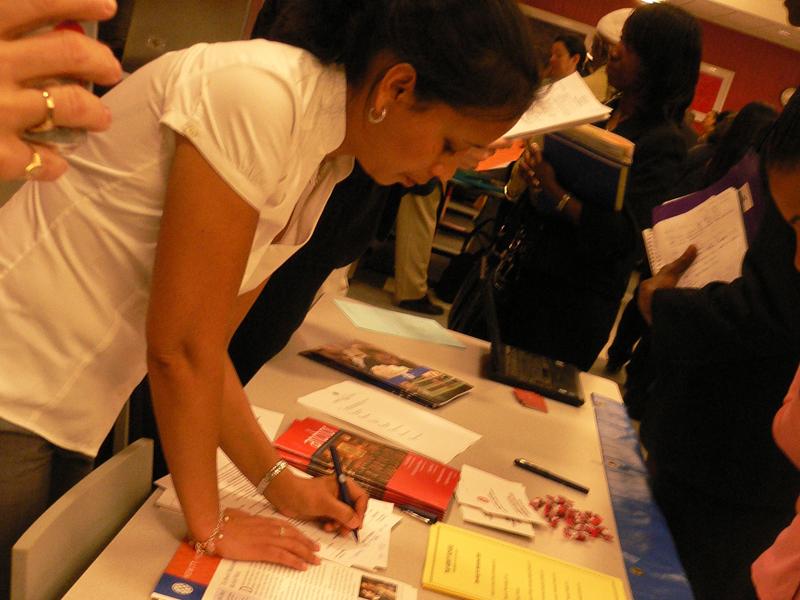Weak demand for new workers keeps long-term unemployment high
A job seeker fills out an application form at a job fair in New York City. The number of unemployed workers who have been unemployed for more than six months is still near record levels. (Courtesy of Arvind Grover/Flickr)
Those who are unemployed for more than six months have a much more difficult time finding a new job.
And they make up a growing share of the unemployed.
Analysts say the long-term unemployment numbers haven’t been this high since the Great Depression. Is it because the unemployed have become dependent on unemployment as some on the political right would say? Or is it because their skills are outdated and they need training as many on the left would say?
According to new research, it’s neither.
Heidi Shierholz, labor market economist at the non-profit, non-partisan Economic Policy Institute said that the underlying cause of long term unemployment is much larger.
“It’s not a worker skills problem. It’s not that people are taking vacation on their UI (un-employment insurance) benefits. It’s because there is very weak demand for workers,” she said.
The latest figures from the Bureau of Labor Statistics says there are 3.7 unemployed people for every job opening, and likely hundreds of applications for each job opening — on average.
“That’s down considerably from the brutal 6.7-to-1 ratio seen in July, 2009. But as Heidi Shierholz of the Economic Policy Institute points out , the current ratio is also higher than at any point during the 2001 downturn,” The Washington Post reported.
Nationally, 6 million more people are unemployed than at the start of the recession, despite the slowly declining overall unemployment rate.
According to Shierholz, in 2007, right before the Great Recession hit, 17.5 percent of the unemployed were unemployed for more than six months. Now 42.9 percent of those who are unemployed have been looking for a job for at least six months. She said demographic shifts have played a large role in the rising unemployment rates.
“Jobs aren’t there across industries, occupations and people with different kinds of skill levels. The one exception is age. Older people who get laid off tend to get stuck in unemployment for longer periods. Those are folks who spent a career developing a specific set of skills and experiences. It takes a lot longer for them to find a good match,” she said.
Shierholz also cited the lack of new jobs for the high long-term unemployment rates.
“The main problem that we’re having right now is a lack of job openings, not that we don’t have the right workers,” she said.
Research on long-term unemployment rates during the Great Recession has shown that the main reason for the increase in long-term unemployment rates is the persistent weakness in demand for workers. The findings suggest the increase in unemployment is because employers do not have work for people.
Shierholz’s solution: Create more jobs in every sector.
“We need to get jobs back more broadly. In a labor market like this, cutting back on unemployment insurance is not going to make people more likely to find work. The reason people are stuck in enemployment is because the jobs arent there. The main result of that is going to be adding more hardships to people that have already been the hardest hit in this downturn,” she said. “Overall, what we need to solve the long-term unemployment problem is not to give people better resume writing skills, it’s actually to get the jobs back.”
Shierholz said the current economic situation is tricky. Usually, during a downturn, the Federal Reserve can step in to reduce interest rates, making money cheaper to borrow. This leads to more business investments, which generates economic activity and creates jobs.
“The problem right now,” Shierholz said, “is that interest rates are near zero. So, there’s very little the Federal Reserve can do to generate jobs.”
The government’s other main tool to fight recession is fiscal policy, Shierholz said. She recommends returning to the policies implemented in the Recovery Act of February 2009.
“Fiscal relief to states, expanded safety net measures and direct job creation programs in hard-hit communities will really stimulate the economy,” Shierholz said.
